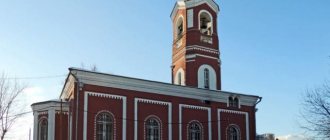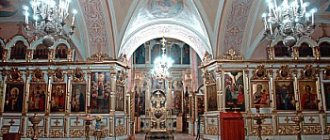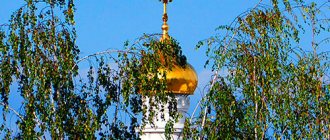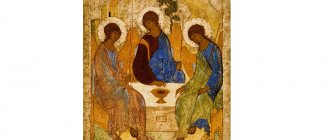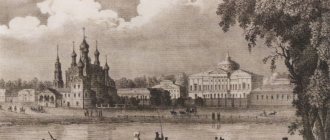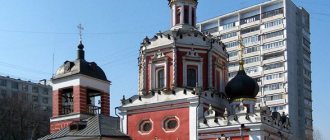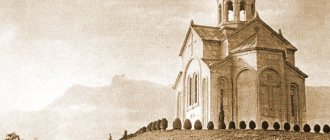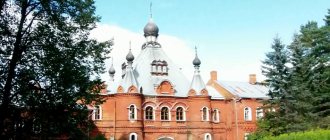Church of the Snows
Non-denominational Christian chapel, one of the southernmost churches in the world. Belongs to the American Antarctic station McMurdo, located on Ross Island. Despite its location, it was destroyed by fire twice. In winter, the church is attended by 200 parishioners, and in summer, the parish grows to 1000 people.
The Church of the Snows tries to meet the needs of adherents of any religion. The Rev. Michael Smith even performed Buddhist and Bahai ceremonies.
Excerpt characterizing the Church of the Snows
“He will probably leave something for Boris,” said the countess. - God knows, chere amie! [dear friend!] These rich people and nobles are so selfish. But I’ll still go to him now with Boris and tell him straight out what’s going on. Let them think what they want about me, I really don’t care when my son’s fate depends on it. - The princess stood up. - Now it’s two o’clock, and at four o’clock you have lunch. I'll have time to go. And with the techniques of a St. Petersburg business lady who knows how to use time, Anna Mikhailovna sent for her son and went out into the hall with him. “Farewell, my soul,” she said to the countess, who accompanied her to the door, “wish me success,” she added in a whisper from her son. – Are you visiting Count Kirill Vladimirovich, ma chere? - said the count from the dining room, also going out into the hallway. - If he feels better, invite Pierre to dinner with me. After all, he visited me and danced with the children. Call me by all means, ma chere. Well, let's see how Taras distinguishes himself today. He says that Count Orlov never had such a dinner as we will have. “Mon cher Boris, [Dear Boris,”] said Princess Anna Mikhailovna to her son when Countess Rostova’s carriage, in which they were sitting, drove along the straw-covered street and drove into the wide courtyard of Count Kirill Vladimirovich Bezukhy. “Mon cher Boris,” said the mother, pulling her hand out from under her old coat and with a timid and affectionate movement placing it on her son’s hand, “be gentle, be attentive.” Count Kirill Vladimirovich is still your godfather, and your future fate depends on him. Remember this, mon cher, be as sweet as you know how to be... - If I had known that anything other than humiliation would come of this... - the son answered coldly. “But I promised you and I’m doing this for you.” Despite the fact that someone’s carriage was standing at the entrance, the doorman, looking at the mother and son (who, without ordering to report themselves, directly entered the glass vestibule between two rows of statues in the niches), looking significantly at the old cloak, asked who they wanted whatever, the princesses or the count, and, having learned that the count, said that their Lordships are worse off now and their Lordships do not receive anyone. “We can leave,” the son said in French. - Mon ami! [My friend!] - said the mother in a pleading voice, again touching her son’s hand, as if this touch could calm or excite him. Boris fell silent and, without taking off his overcoat, looked questioningly at his mother. “Darling,” Anna Mikhailovna said in a gentle voice, turning to the doorman, “I know that Count Kirill Vladimirovich is very ill... that’s why I came... I’m a relative... I won’t bother you, dear... But I just need to see Prince Vasily Sergeevich: because he is standing here. Report back, please. The doorman sullenly pulled the string upward and turned away. “Princess Drubetskaya to Prince Vasily Sergeevich,” he shouted to a waiter in stockings, shoes and a tailcoat who had run down from above and was looking out from under the ledge of the stairs. The mother smoothed out the folds of her dyed silk dress, looked into the solid Venetian mirror in the wall and walked briskly up the staircase carpet in her worn-out shoes. “Mon cher, voue m'avez promis, [My friend, you promised me,” she turned again to the Son, exciting him with the touch of her hand. The son, with lowered eyes, calmly followed her. They entered the hall, from which one door led to the chambers allocated to Prince Vasily. While the mother and son, going out into the middle of the room, intended to ask for directions from the old waiter who jumped up at their entrance, a bronze handle turned at one of the doors and Prince Vasily in a velvet fur coat, with one star, in a homely manner, came out, seeing off the handsome black-haired a man. This man was the famous St. Petersburg doctor Lorrain. – C'est donc positif? [So, is this true?] - said the prince. “Mon prince, “errare humanum est”, mais... [Prince, it is human nature to make mistakes.] - answered the doctor, gracing and pronouncing Latin words in a French accent. - C'est bien, c'est bien... [Okay, okay...] Noticing Anna Mikhailovna and her son, Prince Vasily bowed to dismiss the doctor and silently, but with a questioning look, approached them. The son noticed how suddenly deep sorrow was expressed in his mother's eyes, and smiled slightly. - Yes, in what sad circumstances did we have to see each other, Prince... Well, what about our dear patient? - she said, as if not noticing the cold, insulting gaze directed at her. Prince Vasily looked questioningly, to the point of bewilderment, at her, then at Boris. Boris bowed politely. Prince Vasily, without answering the bow, turned to Anna Mikhailovna and answered her question with a movement of his head and lips, which meant the worst hope for the patient. - Really? - Anna Mikhailovna exclaimed. - Oh, this is terrible! It’s scary to think... This is my son,” she added, pointing to Boris. “He himself wanted to thank you.” Boris bowed politely again. - Believe, prince, that a mother’s heart will never forget what you did for us. “I’m glad that I could do something pleasant for you, my dear Anna Mikhailovna,” said Prince Vasily, straightening his frill and in his gesture and voice showing here, in Moscow, in front of the patronized Anna Mikhailovna, even greater importance than in St. Petersburg, at Annette’s evening Scherer. “Try to serve well and be worthy,” he added, turning sternly to Boris. - I'm glad... Are you here on vacation? – he dictated in his dispassionate tone. “I’m waiting for an order, your Excellency, to go to a new destination,” answered Boris, showing neither annoyance at the prince’s harsh tone, nor a desire to engage in conversation, but so calmly and respectfully that the prince looked at him intently. - Do you live with your mother? “I live with Countess Rostova,” said Boris, adding again: “Your Excellency.” “This is the Ilya Rostov who married Nathalie Shinshina,” said Anna Mikhailovna. “I know, I know,” said Prince Vasily in his monotonous voice. – Je n'ai jamais pu concevoir, comment Nathalieie s'est decidee a epouser cet ours mal – leche l Un personnage completement stupide et ridicule.Et joueur a ce qu'on dit. [I could never understand how Natalie decided to marry that dirty bear. A completely stupid and funny person. Also a player, they say.]
Holy Trinity Church
Church of the Holy Trinity, RF station "Bellingshausen"
There is also an Orthodox church in Antarctica - the Russian Orthodox Church on Waterloo Island not far from the Russian polar station Bellingshausen. The temple was built in Russia, remained there for a year, and then was dismantled and transported to Antarctica. The temple was reassembled on site in 2 months.
The temple can accommodate up to 30 people at a time; a wedding ceremony was even held here. The abbot of the temple changes every year, along with other researchers.
Church of the Holy Trinity in Antarctica
On February 16, 2004, at the Bellingshausen station in Antarctica, the solemn consecration of the Holy Trinity Church, the southernmost Orthodox church in the world, took place. It originated on Altai soil, and this temple was erected by builders from Altai.
The idea of building an Orthodox church was born among polar explorers who devoted more than one year of their lives to exploring Antarctica. The initiators of the project were Valery Lukin, an experienced polar explorer, and Pyotr Zadirov, head of an airline operating in the Arctic and Antarctic. Almost 50 years of Russian work in Antarctica have not been without losses. At a number of Russian stations there are cemeteries where polar explorers, pilots, scientists and specialists of various professions, whose selfless work and whose lives were cut short in Antarctica, found peace. All pioneers, when creating a new settlement, began with the construction of a temple of their denomination. Antarctica is no exception. Catholic churches, churches, etc. were built here. But there was not a single Orthodox church. And this despite the fact that the continent, as is known, was discovered by Russian navigators - F. Bellingshausen and M. Lazarev.
In July 2000, on the initiative of the Russian Association of Polar Explorers, the Russian Orthodox Church, the Russian Antarctic Expedition and Polar Aviation, the charitable foundation “Temple in Antarctica” was established and an all-Russian competition was announced, in which architects from the Altai Territory also took part. The creative laboratory of Peter Anisiforov presented a collective project by Svetlana Rybak and other architects, developed on the basis of the best traditions of Russian wooden architecture.
“There were no special restrictions,” says Svetlana Rybak. The developers were given quite a lot of freedom. I wanted to combine traditional and modern. It is based on the traditions of Siberian wooden architecture. There were several options in the sketches. But in the end we settled on the very first one. This is a temple-monument, a temple-stele.
The selection of projects was carried out personally by the Patriarch of Moscow and All Rus' Alexy II together with representatives of the charitable foundation “Temple in Antarctica”. The project of Svetlana Rybak and her colleagues was recognized as the best, and Alexy II on June 28, 2001 gave his verdict “I agree.”
When developing the project, the harsh natural conditions of Antarctica were taken into account; Altai cedar and larch were chosen as materials for the temple; a unique structure was developed that tightens the frame of the church, as is done in the construction of skyscrapers. In Antarctica, the weather conditions are specific - there are no bacteria dangerous to wood, it does not rot. The structure can stand almost forever. It was decided to install a temple on the northern tip of King George Island, and attach a flashing light to the top of the dome, which would be visible from afar to ships arriving in the bay. The flag of the Altai Territory was fixed on the flagpole of the Bellingshausen polar station, and a sign “Barnaul - 16850 km” appeared on the signpost. The place where the temple was supposed to be built was consecrated on January 20, 2002 and a cross was installed.
In May 2002, a team of Altai builders in the village of Kyzyl-Ozyok on the shore of Lake Teletskoye began construction of the Church of the Holy Trinity. The lower crowns of the temple were cut from larch, the upper crowns were made from Altai cedar. The bulbs of the domes for the temple, including the plowshares of the hipped roof covering, were chopped from aspen blocks. Simultaneously with the log house, the iconostasis and icons were made, and bells were cast. The bells for the belfry were cast at the expense of the descendants of the Muravyov-Apostles abroad. The icons were made by masters from Palekh; one icon of St. Nicholas the Wonderworker was made from semi-precious stones by Ural stone-cutters. The iconostasis of the church was designed by our fellow countryman Evgeniy Skurikhin, a member of the Union of Artists of Russia, and made of durable oak at the Altai company FORANT.
Once assembled, the temple near Kyzyl-Ozyok stood for more than a year. Then each log of the temple was numbered, disassembled and loaded along with cement, equipment for casting the foundation, tools, and auxiliary devices for strengthening the temple onto five trucks and sent to the port of Kaliningrad. Upon arrival, the containers were loaded onto the research vessel Akademik Sergei Vavilov, and on October 1, 2003, the temple sailed to the shores of Antarctica.
On approaching the station, it turned out that there were two Chilean warships in the roadstead. There was no way to get close to the shore. On the barge that was supposed to transport 75 tons of cargo to the station, the crane broke down. I had to do everything manually. The unloading went on for 36 hours non-stop. Everyone unloaded: both the crew and the polar explorers. Barnaul designer Alexander Shmidt is in charge of the unloading.
The group of assemblers was led by an architect from the Altai Republic, Kirill Khromov. His team consists of five people, each of whom has three or four specialties. These are builder Evgeny Rubtsov, hewers Vladimir Korchuganov and Valery Unuchakov, artist-designer Evgeny Skurikhin and architect Vasily Otrishko from Ust-Koksa (Altai Republic).
After inspecting the site, the builders came to the conclusion that it was unsuitable for construction: there was not enough space to expand the construction and, in addition, subsequently it would not be possible to carry out a religious procession around the temple. It was decided to move the construction site several meters deep into the island. The trench for the formwork had to be dug manually, since the radiator in the tractor that arrived on the ship to carry out heavy construction work ruptured due to the low temperature. At the corners of the foundation and under the future altar, stones were laid, specially brought from the Altai land. Iron structures and a device for screeding the chapel were concreted into the foundation.
While the nights were white, the builders worked 12-13 hours a day. They worked in very harsh conditions. Wind speeds sometimes reached 60 meters per second. When laying the logs, I had to hold the cushioning moss with my body and hands, but it was still blown out. For the first time, builders encountered such a phenomenon as horizontal rain. In a strong wind, water penetrated into every groove, swelling into bubbles on the walls from inside the building. We had to use modern building materials such as macroflex and silicone. During its standing in the Altai Mountains, the log house shrank greatly; to assemble the domes, new aspen shares were cut out and installed on the spot. When the chapel was assembled, clamps were made of thick iron under the domes, to which chains were attached. Using springs, they were connected to a metal structure poured into the foundation (this device, as it were, ties the temple to the ground). During the year, Father Callistratus, in addition to the service, had to tighten the springs in order to protect the temple from strong winds.
On February 16, 2004, the solemn consecration of the Holy Trinity Church took place. The Divine Liturgy was performed by the vicar of the Trinity-Sergius Lavra, Bishop of Sergiev Posad Theognost. In the bay, during a religious procession, a huge table iceberg split in two with a roar. Those present at the service considered this a good sign.
In its architectural appearance, the temple resembles a fortress directed upward. On one of the walls of the temple there is a memorial plaque on which the names of the architects and builders of the temple are carved. The church has a height of 15 meters. The size of the polar church allows for services to be held simultaneously for 30 people. There are usually 8 polar explorers wintering at the station, including the priest. The temple is active and services are held regularly. During its existence, wedding rites were performed twice in the Church of the Holy Trinity.
A wooden church for 30 parishioners - the first in the almost 200-year history of scientific exploration of the sixth continent - was installed with money from sponsors, and then donated to the Russian Orthodox Church. Currently, the temple is the Patriarchal Metochion of the Trinity-Sergius Lavra. In 2011, the project “Temple in Antarctica” received a high award at the International Festival “Siberian Pyramid”. Its authors, Barnaul architects Pyotr Anisiforov and Svetlana Rybak, received the main prize of the creative competition of laureates of regional competitions in the field of architecture and design - the golden “Siberian Oscar”, and were recognized as the best at the V International Festival of Architecture and Design “Siberian Pyramid-2011”.
The priests (Lavra hieromonks) in the church changed every year, on approximately the same schedule as the workers of the Antarctic research stations. The priest's responsibilities include providing spiritual care to the personnel of the Russian and other nearby stations and commemorating the 64 Russian polar explorers who died while exploring Antarctica.
Information sources:
Bochkarev A. Temple in Antarctica // Altai Truth. - 2001. - March 31: photo.
Semina T. A unique temple will be built in Antarctica // Altai Truth. - 2001. - December 12: fig.
Teplyakov S. At the ends of the earth // Altai Truth. 2004. April 3
Beloglazova G. Grew from the earth. Connected with the sky / G. Beloglazova, A. Schmidt // Altai Truth. — 2014. — February 15. : photo (full text)
Catholic chapel in the ice cave at Belgrano II station
The southernmost church in the world is located in an ice cave in the Argentine polar region of Belgrano II. Day and night here alternate at intervals of 4 months, and the southern aurora can be seen in the night sky.
Also interesting: “Crypt of the Capuchins”, the imperial tomb of the Habsburgs
Church of Saint Francis of Assisi
The Esperanza research station, where the Church of St. Francis is located, is considered by Argentines to be their southernmost city, although it does not amount to more than a small village. It is one of thirteen Argentine settlements on the continent.
In addition to the church, there is also a permanent school, a museum, a bar and a hospital with a maternity ward, where several Argentines were born.
Notes
- ↑ 123
[www.southpolestation.com/trivia/history/chapel.html History of the founding and restoration of the Church of the Snows] (English). - [www.wn.catholic.org.nz/departments/pastoral-services/wel-com/wel-com-articles/1394 Erebus - a chaplain reflections on a memorial 30 years on] (English) - article in the Wel- Com of
the Archdiocese of Wellington and the Diocese of Palmerston North. - [www.flickr.com/photos/emilywampler/397582480/ Photo of the chalice and some information about it] on Flickr
. - ↑ 1 2 Nicholas Johnson.
[books.google.com/books?isbn=1459617495 Big Dead Place: Inside the Strange and Menacing World of Antarctica].
- Los Angeles: Feral House
, 2011. - P. 309-314. — 566 p. — ISBN 9781459617490.. - [anglicantaonga.org.nz/News/TIKANGA-PAKEHA/Chapel-returning-home-to-Lyttelton Chapel returning home to Lyttelton]. Anglican Taonga. Retrieved November 13, 2012. [www.webcitation.org/6DVm42zdZ Archived from the original on January 8, 2013].
- [www.historic.org.nz/TheRegister/RegisterSearch/RegisterResults.aspx?RID=1929&m=advanced St.
Saviour's Anglican Church (Former) ] (English) in the register
St Saviour's Anglican Church (Former)
.
Chapel of St. Ivan Rylsky on Livingston Island
An Orthodox church built at a Bulgarian polar station founded by four explorers in 1988.
Despite the asceticism, there is even a real bell, donated by the former Deputy Prime Minister of Bulgaria, who once worked at the station as a doctor.
Chilean Chapel of Santa Maria Reina de la Paz
This may be the only church in the world built from shipping containers. Located in Antarctica's largest civilian settlement, Villa las Estrellas. Families of workers from the Chilean military base, to which the settlement belongs, live here year-round. Up to 80 people stay here for the winter, and 120 in the summer. There is also a school, a hostel, a post office and a bank in the village.
Chapel of the Blessed Virgin of Lujan
The chapel is located at another Argentine Antarctic station, Marambio. At the time of construction, this was the first airfield in Antarctica, and it is still used very often. Thanks to this, the station is called the “gateway to Antarctica.”
Another church that deserves attention, but it is not located in Antarctica itself, but nearby, beyond the Antarctic Circle.
Orthodoxy in Antarctica
Share
Church of the Holy Trinity in Antarctica. Photo: Hieromonk Gabriel (Bogachikhin).
Sometimes you meet people who are sure that Orthodoxy is a religion that is geographically quite limited. That is, Orthodoxy is present in a very small number of countries. How surprised are these people when they learn that Orthodox Christians live not only in Russia or, for example, Serbia, but that there are quite a lot of them in the USA, in Western European countries, and in South America.
Recently, Orthodoxy has been present in the very south of our planet - in Antarctica. Once upon a time this continent was considered absolutely dead. But with the development of the system of polar stations, a population appeared in Antarctica. Let it consist entirely of polar scientists and other station employees. However, these people spend months, sometimes years, in Antarctica.
The Russian Church decided not to leave these people without spiritual support. Since the early 90s of the 20th century, there have been conversations about an Orthodox church appearing in Antarctica. But the transition to the concrete implementation of these plans took place only in 2002, when the consecration of the site for the construction of an Orthodox church on the Island of Waterloo, near the Russian polar station Bellingshausen, took place. The temple was planned to be made of wood. It was made by Altai craftsmen. They first assembled it and then disassembled it for ease of transportation.
In this disassembled form, the temple was first transported to Kaliningrad, and from there it was delivered by ship to Waterloo. The temple was assembled and consecrated in honor of the Holy Trinity in 2004.
The Antarctic Temple is now the courtyard of the Trinity-Sergius Lavra. It is from this ancient Russian monastery that monastic priests travel to Antarctica every year to perform divine services in the Church of the Holy Trinity.
Usually one priest-monk and one his assistant travel. They spend exactly one year in Antarctica. Then new ministers come to replace them. The inhabitants of the Lavra live in a special house next to the temple.
I was able to talk with one of the priests who spent a year in Antarctica. When I asked what was the most difficult thing for him during this time. He unexpectedly answered - no flowers. Here in Russia we are accustomed to color diversity; we do not notice or appreciate it.
In Antarctica, people see only three colors - white, gray and black. There is no vegetation, it is almost always cloudy there and therefore the blue of the sky is not visible.
Antarctica is also permanently static. You can’t go outside there unless you have to (a strong wind is constantly blowing), so there is no traffic outside the window that we are used to. As that monk told me, he never thought that the arrival of the penguin would be perceived as a holiday.
But despite all the difficulties, this monk returned to Antarctica several times, because it was there that he felt what real solitude was and how powerful a person’s prayer could be among the white expanses of the southernmost territory of the Earth.
Whalers Church
This Norwegian Lutheran church was built in the whaling village of Grytviken, South Georgia in 1913.
The church was built by the sailors themselves, and this is the only building in the village that is used for its original purpose. The whaling station itself was abandoned in 1966.
During the “heyday” of the station, up to 300 people lived and worked here at the same time. Abandoned cinema:
Also interesting: St. Gallen, monastery of ancient manuscripts
The whale population around South Georgia declined steadily until the station was closed. To this day, in the vicinity of the village you can find animal bones, rusted remains of ships and factories for processing whale oil.
